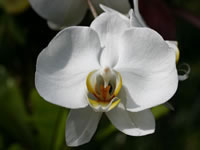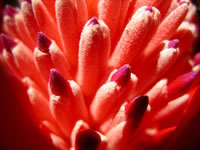| |
 |
Kapok Trees are large trees native to Mexico, Central America, South America and west Africa. These massive trees can grow to 230 feet in length and often burst through the rainforest canopy, forming an emergent layer of the rainforest. Trunk diameters can exceed 10 feet and are sometimes supported by large buttresses (supports), which also store moisture. The trunk and branches are often covered with sharp thorns. Mayans held the Kapok tree is high esteem and considered it scared.They believed it was the "tree of life" and that its roots extended into the underworld and the branches extended into heaven. |
|
| |
|
 |
Epiphytes - An epiphyte is an organism that grows on another organism. Fungi, mosses, lichens, algae and higher plants can be epiphytes. Usually, epiphytes only derive physical support from the host plant, rather than nourishment. Nevertheless, some bromeliads harm their host plants. Orchids, Strangler Figs, and bromeliads are probably the best-known epiphytes. |
|
| |
|
 |
Bromeliads - A Bromeliad is an epiphytic or terrestrial plant able to store water in "tanks" formed by overlapping leaves. More than 11,000 different organisms utilize the bromeliad as a source of water. Some organisms are found exclusively within bromeliads. The Bromeliads are a broad family of flowering plants, with more than 2,400 species identified. They are native to parts of Florida, the Caribbean islands, Mexico, Central America, and South America, with one species present in west Africa. Pineapples are the best known species of bromeliad. They are the only bromeliad fruit that is commonly cultivated and sold. |
|
| |
|
 |
Ferns - Ferns are common rainforest plants that are found in many ecosystems around the world including rainforests, deserts, alpine regions, and wetlands. Ferns are considered vascular plants - those that have internal tubes for transporting food and nutrients. They do not have flowers and do not reproduce with seeds. They are considered weeds in some locales. Ferns have been in existence for more than 300 million years and there are thought to be more than 20,000 different species of ferns. There is an entire field of science devoted to the study of ferns called pteridology. |
|
| |
|
 |
Lianas are rooted vines that obtain vertical support by using trees to propel into heights in the rainforest canopy that receive light. Lianas often form bridges are connections between trees in the canopy that allow organisms to move from tree to tree or away from predators. Many organisms use lianas such as lemurs, monkeys, and tamarins. Such organisms may be able to travel through the entire forest using lianas. Some lianas are extremely thick and look like trees intertwined in the canopy. They can grow to over 3,000 feet in length (more than half of a mile). Some lianas, such as rattan, are used to make furniture and ropes. |
|
| |
|
 |
The Rubber Tree is an important economic tree in the rainforest because its sap, known as latex, is the main ingredient in rubber. When a rubber tree is five or six years old, incisions are made in the tree's trunk, just deep enough to "tap" the tree's sap. The sap is collected in buckets and the latex extraction process is known as "rubber tapping." Most rubber trees stop producing latex after they are thirty years old. These trees are not harmed in the latex collection process. The Rubber Tree can rise to heights of about 100 feet. |
|
| |
|
 |
The Cacao Plant is one of the most important economic plants in the world. Native to the Amazon and Orinoco River Basins, the Cacao Plant is a small evergreen tree that is responsible for the eventual production of chocolate. The Cacao Plant produces pods which yield between 20-40 seeds which are fermented until they become brown and produce the familiar chocolate flavor. These seeds were originally used as currency by the Incas. They are then shipped to processing plants where they are ground into a paste. It is this paste that forms the basis of all chocolate products. |
|
|
|
|